Excerpts from Jim Conrad's
Naturalist Newsletter
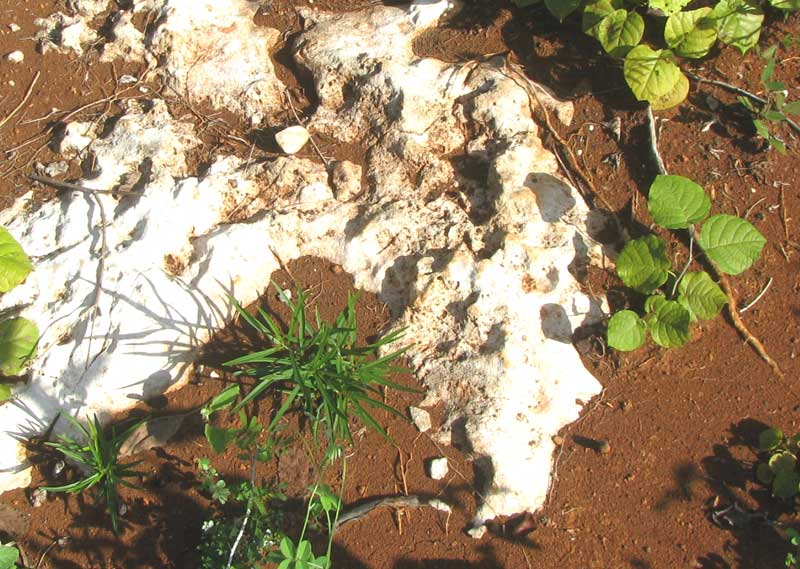
from the January 29, 2012 Newsletter issued from Hacienda Chichen Resort beside Chichén Itzá Ruins; limestone bedrock; elevation ~39m (~128ft), N20.675°, W88.569°; central Yucatán state, MÉXICO
THE YUCATAN'S RED & BLACK SOILS
Just north of Pisté in a cornfield lying fallow for the dry season the soil is thin and red, with much limestone bedrock emerging from it, as shown above. Maybe a hundred feet away the soil is black, but anthills built of deeper-mined soil are red, as shown below:
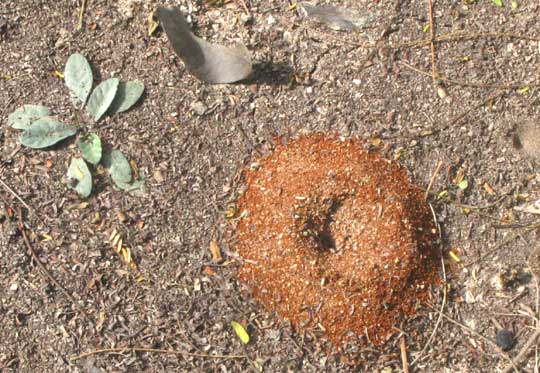
The Maya know that the black soil is richer and easier to cultivate. Black soil holds water longer and doesn't dry into hard, brittle clods as red soil does. Sometimes the Maya carry black soil to areas of red soil where they want to grow something special.
All this makes sense because black soil contains higher concentrations of organic matter -- decomposing remains of living organisms -- while red soil holds much less. And soil organic matter behaves like a sponge in soil, not only holding water there but also nutrients. Black soil dries into a crumbly state instead of bricklike like red soil. Water-saturated black soil also tends to be crumbly instead of soupy as with red soil.
The Yucatán's limestone-derived soil is red because the limestone from which it derives contains small amounts of iron. When iron is exposed to oxygen, iron oxide is formed, and iron oxide is reddish. In the mineral form iron oxide is known as the reddish hematite; on gate hinges it's known as rust.
Therefore, for as long as soil keeps developing from limestone there'll be red soil. However, black soil is fragile and easy to destroy. Expose it to air and heat and it converts to nutrients that leach away, or its molecules are oxidized and mineralized, losing their beneficial organic properties. In the Yucatán, red soil is replacing black soil.
A technical article in the journal Agronomy (vol. 22, #3, April 2002) reports on soil studies in the Yucatán where forests are cleared and burned, cornfields are planted, then, when the soil deteriorates and weeds and insects invade, the fields are abandoned and allowed to revert to forest. The whole cycle is referred to as slash-and-burn. Because of ever-increasing population pressure, the time allowed for fields to remain abandoned, or fallow, as vegetation re-enriches the soils, is ever briefer.
The study found that as the fallow time "is shortened from the traditional 25-30 years to 6-12 years, soil productivity declines... Black soils contained twice as much organic matter, more total P {phosphorus} and three times more available P than red soils. At the end of the cultivation cycle both soils had lost one quarter of their organic matter relative to the longest fallow."
Online you can search for this paper under the title "Soil fertility during shifting cultivation in the tropical Karst soils of Yucatan" at http://www.agronomy-journal.org/.
from the January 3, 2016 Newsletter issued from Hacienda Chichen Resort beside Chichén Itzá Ruins, central Yucatán, MÉXICO
RED SOILS, VOLCANOES & DESERTS
One of the pleasures of being at Hacienda Chichen is that sometimes very interesting visitors pass through. That was the case last week when a couple of scientists on sabbatical from the University of California at Riverside, and a friend, walked up to the hut one evening as I was snipping whiskers with a lady's compact mirror held before my face. The scientists had conducted soil and plant community studies at El Eden, a reserve 40 kms west of Cancún.
That evening with the half moon above us I learned a lot about the Yucatan's red soil. Geologically, the Yucatan is a massive block of limestone, so up to now I've assumed that the Yucatan's red soil was more or less equivalent to red soils I know very well, also developed atop limestone, in the US Southeast. The short story for the northern red soil is that as the limestone dissolves it leaves behind traces of iron, which oxidize, and oxidized iron -- often known as rust -- is reddish.
I've long suspected that the Yucatan's red soil had something peculiar about it because often you see Maya cornfields, or milpas, on very thin red soil, often with white limestone poking through here and there, and the crops seem to be growing fairly well there. Up north in such thin, red soil atop limestone you don't bother trying to grow things, because it's just too "poor" -- too few nutrients for plants to thrive and not enough organic matter to hold water.
My guests' preliminary studies at El Eden seem to suggest that the secret ingredient of the Yucatan's red soil is volcanic ash. Not just ash deposited during the last few centuries, but during the last few millions of years, when the limestone or precursor to limestone beneath our red soil was forming at the bottom of a shallow sea, occasionally being augmented with significant wind-deposited volcanic ash. That's important, because volcanic ash carries minerals such as phosphorus and magnesium, which are critically important to plant growth. Today, as the limestone dissolves below the Yucatan's thin soil, it leaves behind not only iron that reddens the soil, but also plant nutrients that help green the landscape with healthy, luxuriant growth.
On the Internet several papers document not only the contribution that millions of years of volcanic ash have made to the Yucatan's soil, but also the enriching effects of Saharan dust -- dust carried here on winds blowing from northern Africa's Sahara Desert, across the Atlantic, to the Caribbean/Yucatan region. A 2012 article by R. Das and others, abstracted at The Smithsonian/NASA Astrophysics Data System website, entitled "Saharan dust in Yucatan soils: Sr isotope and trace element evidence of dust inputs," documented that:
"Saharan dust transport is an important source of material for soil development in Caribbean islands, and may even be a larger source than the weathering of parent material on calcareous substrates in the Florida Keys and Bahamas."
By "calcareous substrate" is meant "limestone."
The researchers found evidence of Saharan dust on the Yucatan's red soil, but couldn't determine how important it was relative to other inputs, such as the limestone bedrock dissolving, and volcanic ash being deposited.
My curiosity aroused by the visitors from Riverside, the next morning on a bike trip to Pisté to buy bananas, I paid special attention to the fresh roadcuts made by the recent highway widening. A hard-to-interpret formation with white limestone seeming to finger up through red stuff above it is shown below:
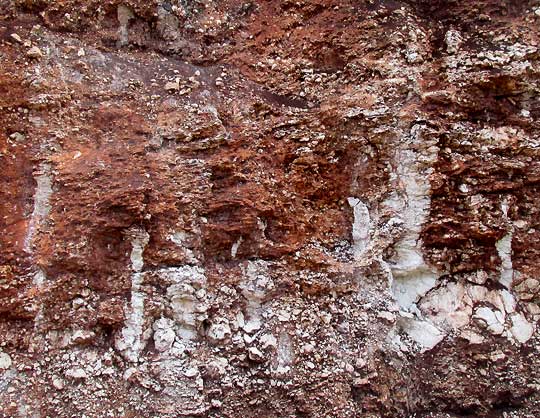
That mystery resolved itself when I went up to the formation and scratched the wall with my fingernails. The whole roadcut was composed of white limestone, just that red dirt from above had washed down over the entire face. Machinery had streaked the face with vertical scars exposing white limestone. The fingernail scratching test often is a good one in the field.
At another place, bands of white limestone appeared with what seemed genuinely red-hued limestone, which one could easily imagine contained ancient volcanic ash or Saharan dust, shown below:
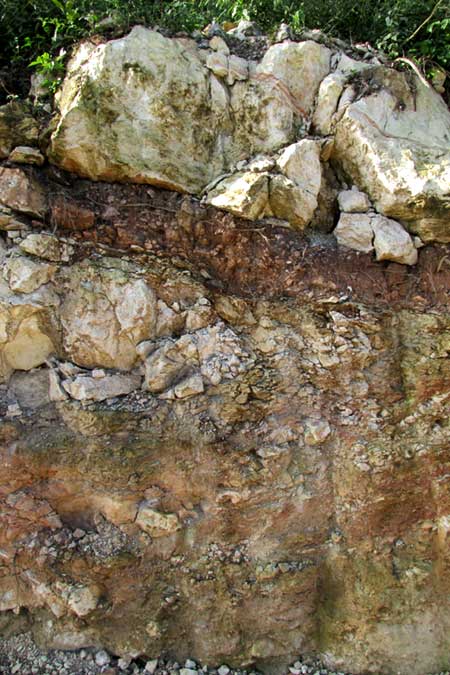
A close-up of one reddish layer is shown below:
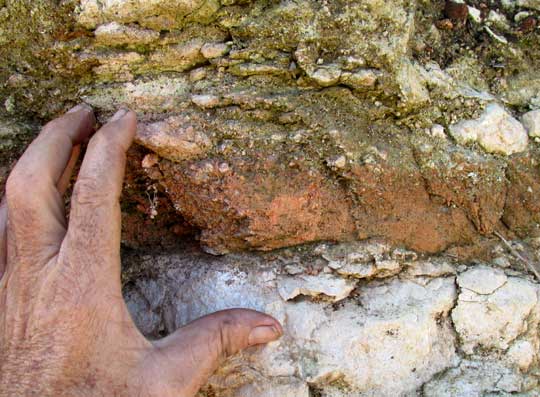
Wind-deposited volcanic ash and Saharan dust well may have bestowed the Yucatan's red soil with a fairly unending supply of nutrients absolutely necessary for agriculture, but also at least some researchers think that volcanic eruptions may have been responsible for the collapse of Classic Mayan civilization, which set the stage for the flowering of a Postclassic Maya flowering here at Chichén Itzá.
In a 2014 paper by Heajoo Chung and Youngsun Song appearing in "Mediterranean Archaeology and Archaeometry," entitled "The meaning of volcanic ash characteristics found in the archaeological pottery of Chichen Itza, Yucatan, Mexico," the authors speak of an eruption of El Chichón volcano in Chiapas, southern Mexico, near Yerba Buena Clinic from which I've often written. They say:
"The El Chichon volcano eruption destroyed many of the Mayan cities in the area. The destruction and subsequent social upheaval caused the collapse of the Classic Mayan civilization. As well, the eruptions forced the population to leave their homeland and move far from the volcanoes, to the area around Chichen Itza in the Northern Yucatan."
This isn't a universally accepted theory, but the authors do provide data emphasizing the importance of volcanic eruptions to ancient and modern Maya society. That paper can be freely downloaded in PDF format here.